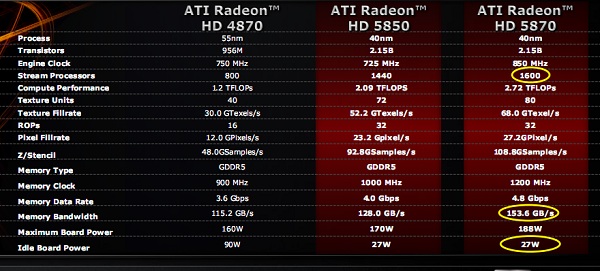How to cut it down to size?
How to cut it down?At the outset, please appreciate that the Radeon HD 5850 is architecturally identical to the Radeon HD 5870. Please head on over to our in-depth look of the original DX11 GPU.

Image courtesy of AMD
Aiming for greater yields, the core speed is dropped from 850MHz to 725MHz. Further, AMD's reduced the shader-blocks from 20 to 18, leading to a total of 1,440 stream processors. The coupling of texturing units to the SIMD engine means that texturing is commensurately down, as well.
It's good to see that the snipping of shader-blocks isn't complemented by an additional reduction of ROPs - they remain at a HD 5870-matching 32.
The reduction in power is accomplished via the disabling of various features rather than a new ASIC. Both high-end GPUs share the same 2.15bn-transistor die.
Radeon HD 5870 uses the fastest card-mounted GDDR5 we've ever seen, operating at an effective 4.8GB/s. HD 5850 reduces the bill of materials (BOM) cost by implementing 4.0GHz-clocked RAM, as found on present Radeon HD 4890s.
A desirable consequence of reducing frequencies and shader-blocks is lower power-draw, manifested in board juice of 151W, compared to 188W for the HD 5870.
Talking numbers
The double-whammy of lower core clocks and fewer shaders means that computational throughput is hit hardest - down some 23 per cent from the faster card. Texturing also sees a similar fall, obviously.
Pixel fillrate doesn't see quite a chop because it's shader-agnostic. Memory bandwidth, too, isn't hurt quite as badly, reduced by some 16.6 per cent.
The upshot?
We'd bet a significant chunk of change that the DX11-compliant Radeon HD 5850 GPUs are those that fail the gold grade of HD 5870 and are then speed-binned for the cheaper card.
Given what we know about the frequencies and architecture, performance should be around 70 per cent of the HD 5870, at a price that's around 70 per cent of the better-specified card. Kind of matches up nicely, don't you think?









